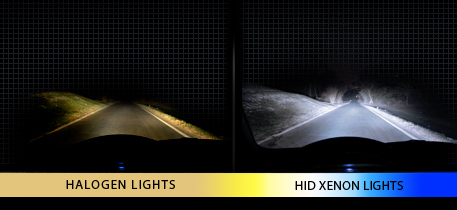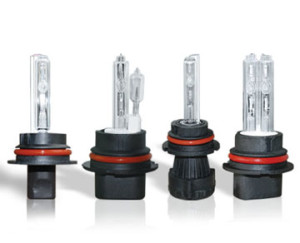Remember when HID lights were introduced to the automotive crowd? The beautiful bright white light coming from high intensity discharge bulbs replaced the ugly yellow-emitting stock halogen headlamps that almost every vehicle had. As time passes, technology advances with better, longer lasting lights for everyone. The automotive industry started with halogen bulbs, as they were easy and cheap to produce, but high intensity discharge bulbs and now LED (light-emitting diode) bulbs are hitting the market fast. This guide is to help you decide what is best for your vehicle, but of course it will come down to personal preference.
Almost every vehicle on the market comes with halogen headlamps as standard equipment. There are reasons why these bulbs are so popular -- they are easy to manufacture, which makes the manufacturing process less expensive. A single halogen light bulb should have a lifetime of roughly 1,000 hours depending on the conditions it's exposed to. Replacement cost for these bulbs averages around $30 and they are available at most any automotive shop. They can come in all sizes and shapes to fit most vehicles.
The downside of halogen bulbs is that they are not very energy efficient and require special care when handling them. First, let's explain how the bulbs work. Halogen bulbs are made of high temperature-resistant glass, a gas combination of argon and nitrogen, and a tungsten filament. Light is created from the filament getting electricity passing through and heating up to 2,500 celsius, which creates the glow. Once the bulb reaches the end of its life, the tungsten in the filament evaporates, leaving its deposit on the gas that will eventually cause the filament to rupture.
The issue here is that when these bulbs generate light, the amount of heat coming from the bulb is wasted energy. Remember the disclaimer for users to not touch the glass? That is because the grease on your fingers will stick to the quartz glass, causing the bulb to heat unevenly. This will eventually shorten the life of the bulb.
Halogen bulbs will be the go-to for most carmakers as they still hold many advantages: cheap for the amount of light produced, come in many sizes and are dimmable, allowing carmakers to build multiple versions. Looking for that upgrade from halogen to HIDs? Check for your HID conversion kit. Start by finding your bulb type.
Pros:
-
Cheap
-
Many sizes available
-
Easy to replace
Cons:
-
Energy wasting
-
Extra care required

Halogen light spread vs HIDs light spread
HID (High Intensity Discharge) headlamps, also known as Xenon headlamps, have been doing well in the market because they are more efficient than halogen, but mostly because of their various color temperatures and how bright they can get.
HID bulbs are enclosed tubes filled with gases, an electrode at each end, and an electric current passing through to emit light. Xenon gas is needed only at start-up but HIDs use a metal-halide mix. There are three steps in lighting an HID bulb:
-
A high voltage pulse produces a spark that ionizes the xenon gas, creating a tunnel of current between electrodes.

Various bulb sizes available for most vehicles
-
The temperature in the bulb rises quickly, vaporizing the metallic salts and lowering the resistance between the two electrodes.
-
The ballast switches to continuous operation, supplying the bulbs a continuous amount of power so that the electric arc will not flicker.
Advantages: Xenon headlights produces more light than halogen and much more efficiently. A xenon bulb produces 3000 lumens, while a halogen bulb generates 1400 lumens. HIDs have a long lifespan, estimated at around 2,000 hours.
Disadvantages: HIDs need a few seconds to reach full brightness, which will require many vehicles to go with low beam HIDs and high beam halogens (choosing a hi/lo unit allows both high beam and low beam to work by using a mechanical shade inside the reflector). Some bulbs may contain harmful substances that are hazardous to our health and should be handled carefully. Some complain that HIDs generates glare that could blind oncoming traffic.
-
Energy efficient
-
Brighter lights with higher visibility
Cons:
-
More expensive than halogen
-
Glare issue
-
Complex design
-
Lag time for full brightness
Light emitting diodes (LEDs) are the new technology to replace halogens and HIDs. To explain how they work scientifically, negative electrons move against positive holes across a semiconductor. When a free electron falls into a hole that sits on a lower energy level it will lose its energy, which is released as a photon. The continuous bright light is produced from this process when it occurs thousands of times.
LED headlights require very low power to work compared to halogen and HIDs. When it comes to the luminescence of LEDs, they fall between halogen and HIDs but LEDs provide much more focused rays. The smaller LED design allows manufacturers to create all kinds of shapes and assemblies.
There are some issues with LEDs that buyers should know. Even though LEDs do not emit heat from the lighting process, they do create heat at the bottom of the emitter. This could create a potential risk for adjacent assemblies and connectivity. Buyers shouldn’t be concerned if they choose well-made LED headlights, which will have a cooling system, like a heat sink or fans, to keep them from melting.
The assembly of LEDs is harder to design and is more complex, leading to the higher costs compared to Halogens and HIDs.
Pros:
-
Low energy
-
Brighter than halogen headlights
-
Sharper and crisper than HID with no glare
-
Small sizes with various shapes
-
Longer lifetime compared to halogen and HIDs
Cons:
Other manufacturers have huge issues getting the correct beam pattern -- light is scattered even though it’s bright enough. Our unique design and bubble technology delivers OEM grade beam pattern.
HIDs and LEDs are leading the way in headlight technology, as we slowly get away from halogen bulbs in the automotive market. HIDeXtra has been leading the industry offering HIDs and now offering affordable LEDs for many vehicles.
The new and exciting LEDs from HIDeXtra have a lifespan of 10,000 hours, which is more than three times that of HIDs. Our lights come with a 1-year warranty and are guaranteed to last for many years. We will be offering LED lights in various sizes to fit most vehicles. Please call us for availability and visit our site www.trutecled.com for more information as it becomes available. You can preorder your LED headlights
